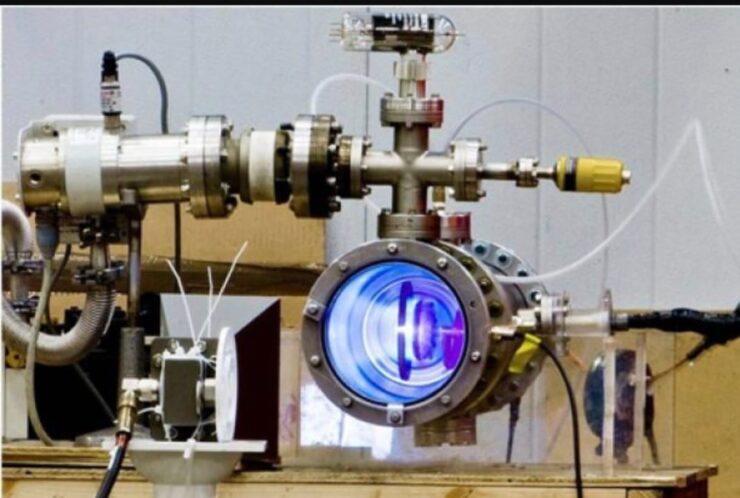K𝐀𝐋𝐈, the acronym for Kilo Ampere Linear Injector, is a top-secret weapon that India has designed as a potential response to any incoming missiles whose objective would be to disrupt the country’s peace. It is believed that our neighbours – Pakistan and China are not only in possession of adequate information about this weapon (that they refuse to discuss openly) but also fear it. It is imperative to look at how KALI works and its specifications to understand its potency as a weapon.
WHAT EXACTLY IS KALI?
The KALI technology, developed indigenously in India by Defence Research and Development Organisation and the Bhabha Atomic Research Centre, has been in the works since 1989. Originally intended for industrial purposes, it has immense potential to be weaponised. KALI is a linear electron accelerator or a particle accelerator – in simpler terms, this means that it can emit powerful Relativistic Electron Beams (REBs). Different components act together to generate powerful pulses of electrons which are converted into electromagnetic radiation in the form of X-ray or microwave frequencies.REBs are not to be confused with laser beams, which are different since they bore a hole in the target and destroy it. REBs in KALI are actually microwaves packed with gigawatts of power that ultimately damage the target’s electronic system.
The series has improved consistently, progressing from KALI 80 to KALI 200, followed by KALI 1000, KALI 5000, and now by KALI 10000. The weapon is also known as “Single Shot Pulsed Gigawatt Electron Accelerator” since all KALI devices are known to be single-shot devices.
HOW POWERFUL IS KALI?
The KALI-5000 is a pulsed accelerator with 1 Mega electron volt (MeV) electron energy. It also has 50-100 nanoseconds (ns) pulse time, 40 kilo amperes (kA) current, and 40-gigawatt (GW) power level.
The system is quite bulky as well, with the KALI-5000 weighing 10 tons and the KALI-10000 weighing 26 tons. They are also very power-hungry, needing a cooling tank of 12,000 litres of oil. There is also a very long recharging time – in fact, too long to make it a viable weapon in its present form.

KALI functions via the emission of powerful pulses of REB. These electrons are converted into electromagnetic radiation, which can be adjusted either to X-ray (flash X-rays) or microwave (high power microwave) frequencies. KALI can be used as a high-power microwave gun with these microwaves.
As a high power microwave gun, KALI will produce a tremendous amount of microwaves. When this blast of 1000 million GW microwaves is directed towards adversary projectiles or aircraft, it can obliterate their electronics circuit and any computer chip embedded there. These would completely paralyse computer systems and take them down.
The military could also use these electrostatic shields to protect electronic circuits against Electromagnetic Impulses (EMI) generated by nuclear weapons and additional cosmic disturbances. Such a shield could also potentially be used for safeguarding LCA Tejas. The electrostatic guards can also be put to use for the protection of satellites. However, the real-time application of KALI in the field of defence is a thing of the future. The system is still under development. Currently, there are efforts to make it more compact and to improve the system’s recharge time, which, at present, makes it only a single-use system.
𝗨𝗦𝗘 𝗜𝗡 𝗛𝗬𝗣𝗢𝗧𝗛𝗘𝗧𝗜𝗖𝗔𝗟 𝗪𝗔𝗥 𝗦𝗖𝗘𝗡𝗔𝗥𝗜𝗢
KALI’s design enables it to destroy aircraft and missiles through soft-kill. In a hypothetical scenario where India is under attack, enemy missiles and fighter planes will likely be encroaching eastern and western borders for an offensive. There would be tanks on the Rajasthan border moving in for the attack, and the chances are that there would also be naval ships surrounding the country’s coastal areas.
While India will, of course, have its military- the fourth-largest in the world- supported by sophisticated and ultra-fast aircraft and fighter jets, one of the best infantries, and multi-functional naval vessels and submarines, the addition of KALI could be a game-changer. This weapon’s use would amount to a burst of light coming out suddenly and almost immediately taking down all the fighter aircraft, enemy tanks, and missiles on the battlefield.
𝗧𝗘𝗦𝗧𝗘𝗗 𝗔𝗡𝗗 𝗨𝗦𝗘𝗗?
Some believe that India has already conducted a successful test of KALI. Unconfirmed reports have blamed India for the Siachen glacier avalanche in 2012, which has caused the death of around 135 Pakistani soldiers. Some sources have claimed that the melting of rigid ice sheets in the region resulted from KALI’s successful test. There have also been reports of placing the weaponised KALI in an IL-76 aircraft as an airborne defence system.
However, the Government of India has not spoken up about this project.
– The writer is an Aerospace and Defence Analyst & Director ADD Engineering Components (India) Pvt Ltd (An Indo- German Company).
-The author is a Defence, Aerospace & Political Analyst based in Bengaluru. He is also Director of ADD Engineering Components, India, Pvt. Ltd, a subsidiary of ADD Engineering GmbH, Germany. You can reach him at: girishlinganna@gmail.com. The views expressed are personal and do not necessarily carry the views of Raksha Anirveda






